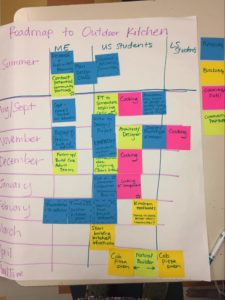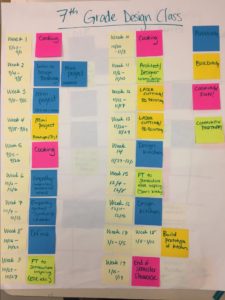(written by Rachel for Designing Purposeful Making Experiences, Jun 2017)
A few years ago, I biked to a neighborhood church in Berkeley to see Naomi Klein, one of my all-time heroes, speak about her new book, This Changes Everything: Capitalism vs. the Climate. During her talk, Klein – a master journalist, speaker, and storyteller – wove a pretty compelling narrative about the social, economic, and political systems that have given rise to climate change, how these systems are failing both the planet and the majority of humanity, and the need to confront and replace these dominant structures in order to weather the proverbial (and not-so-proverbial) storm. As she spoke about the next phase of climate activism, she offered a piece of advice that gave me goosebumps at the time and has stuck with me ever since: “Dream in public.” In other words, our most powerful tool in addressing social inequality and collapsing ecosystems is our collective ability to articulate and iterate a new vision of what might be possible. Our salvation lies in our imagination.
As I think about designing purposeful making experiences, “dream in public” again comes to mind. If our future depends on redesigning the human experience – of suggesting and creating new ways to thrive together – purposeful making is a critical opportunity to develop this imaginative skill set in our students. Purposeful making provides students with the space and support to practice bringing their vision into reality.
As everyone who has followed a dream knows, the process of bringing a new and meaningful idea into reality can be a bumpy one. We might doubt ourselves, our team, or even our dream itself. We might start to use words like “impossible,” feel tempted to give up, or discredit the dream (“It didn’t really matter to me anyway”). Some of my friends at the Academy for Coaching Excellence call this experience of meeting resistance as we bring our dreams into reality “trouble at the border.” Since this trouble at the border is a common experience as we reach farther and think bigger, purposeful making prepares students with the tools to persevere through challenges and see obstacles as opportunities for learning and growth.
During the Designing Purposeful Making Experiences workshop, I started to envision one project that will help my students develop this skill set of imagination and persistence. I aspire to work with students to design and build an outdoor cooking space. This outdoor kitchen will support interdisciplinary learning, complement the school’s existing garden program, and deepen students’ food literacy. 7th grade students will kick off the design process in a semester-long design thinking course that will involve empathizing with peers, teachers, administrators, and parents about a potential cooking program/space, visiting other programs for inspiration and guidance, and applying new laser cutter and 3D-printing skills to build and present prototypes of the outdoor kitchen space. This project will be purposeful because it will provide students with the opportunity to learn and apply design thinking skills – which will support them to imagine and persist into the future – and create a resource for the school community – to see a big idea move from vision to reality.
I am inspired by the power we as maker educators have to equip the next generation of dreamers and builders. I appreciate the Designing Purposeful Making Experiences workshop for helping me to see this purpose in our work. Keep dreaming in public – there’s no limit to what we might do!
Rachel Fryke is the Garden Educator and Associate Science Teacher at Black Pine Circle School, an independent K-8 in West Berkeley. In her role, she helps integrate experiential and maker-centered learning into science, gardening, and workshop classes.


